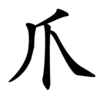爪
| ||||||||
Translingual
| Stroke order | |||
|---|---|---|---|
 | |||
Alternative forms
- 爫 – when used as a top radical
Han character
爪 (radical 87, 爪+0, 4 strokes, cangjie input 竹中人 (HLO), four-corner 72230, composition ⿸𠂆⿰丨乀)
- Kangxi radical #87, ⽖.
Derived terms
- Index:Chinese radical/爪
References
- KangXi: page 688, character 26
- Dai Kanwa Jiten: character 19653
- Dae Jaweon: page 1101, character 12
- Hanyu Da Zidian: volume 3, page 2030, character 1
- Unihan data for U+722A
Chinese
| simp. and trad. |
爪 | |
|---|---|---|
| variant forms | 㕚 ancient | |
Glyph origin
| Historical forms of the character 爪 | |||
|---|---|---|---|
| Shang | Western Zhou | Shuowen Jiezi (compiled in Han) | Liushutong (compiled in Ming) |
| Oracle bone script | Bronze inscriptions | Small seal script | Transcribed ancient scripts |
 |
 |
 |
 |
| Characters in the same phonetic series (爪) (Zhengzhang, 2003) | |
|---|---|
| Old Chinese | |
| 抓 | *ʔsruː, *ʔsruːʔ, *ʔsruːs |
| 爪 | *ʔsruːʔ |
| 笊 | *ʔsruːʔ, *ʔsruːs |
| 找 | *ʔsruːʔ |
Pictogram (象形) – a hand grabbing from above (in earlier forms from side); compare 手, 寸, 九.
Pronunciation
Definitions
爪
Usage notes
- 爪 (zhuǎ) ― paws or claws of vertebrates, except for humans, bears, ducks, geese and swans
- 鉗/钳 (qián) ― claws of arthropods (crabs, clawed lobsters, scorpions, etc.)
- 掌 (zhǎng) ― hands, paws or claws of humans (only in compounds), bears, ducks, geese or swans
- 手 (shǒu) ― hands or hooves of humans or swines (only when swine hoof as a food)
- 蹄 (tí) ― hooves
Compounds
|
Japanese
Etymology 1
| Kanji in this term |
|---|
| 爪 |
| つめ Grade: S |
| kun’yomi |
From Old Japanese,[1] in turn from Proto-Japonic *tumay. The standalone form of tsuma below.[1] Likely derived as a fusion of tsuma + emphatic nominalizing particle い (i), similar to the phonetic development of 目 (me, from ma + i) or 神 (kami, from kamu + i).
Derived terms
- 鷹の爪 (taka no tsume)
Etymology 2
| Kanji in this term |
|---|
| 爪 |
| つま Grade: S |
| kun’yomi |
From Old Japanese, presumably in turn from Proto-Japonic *tuma. The root form of tsume above, generally only used in compounds. Cognate with 端 (tsuma, “edge, side of something”) and 妻 (tsuma, “wife”, original sense of “spouse”).[1]
Derived terms
Derived terms
- 爪音 (tsumaoto, “the sound of a stringed instrument when plucked with a pick or plectrum; the sound of a horse's hoofbeat”)
- 爪折る (tsumaoru, “to pick or break something off with one's fingernails”)
- 爪隠, 爪隠し (tsumakakushi, “hiding one's claws; a kind of zōri grass sandal, where the front end extends and folds over the tops of the toes”)
- 爪先 (tsumasaki, “tiptoe”)
- 摘まむ (tsumamu, “to pinch; to pick at; to pick something up with the tips of one's fingers”)
- 摘む (tsumu, “to pick something up with the tips of one's fingers; to snip the tip off of something”)
- 躓く (tsumazuku, “to stumble”)
- 爪楊枝 (tsuma yōji, “a small toothpick”)
References
- 1988, 国語大辞典(新装版) (Kokugo Dai Jiten, Revised Edition) (in Japanese), Tōkyō: Shogakukan
- 2006, 大辞林 (Daijirin), Third Edition (in Japanese), Tōkyō: Sanseidō, →ISBN
Khitan
Korean
Hanja
爪 • (jo) (hangeul 조, revised jo, McCune–Reischauer cho, Yale co)
- This term needs a translation to English. Please help out and add a translation, then remove the text
{{rfdef}}.
Vietnamese
This article is issued from
Wiktionary.
The text is licensed under Creative
Commons - Attribution - Sharealike.
Additional terms may apply for the media files.